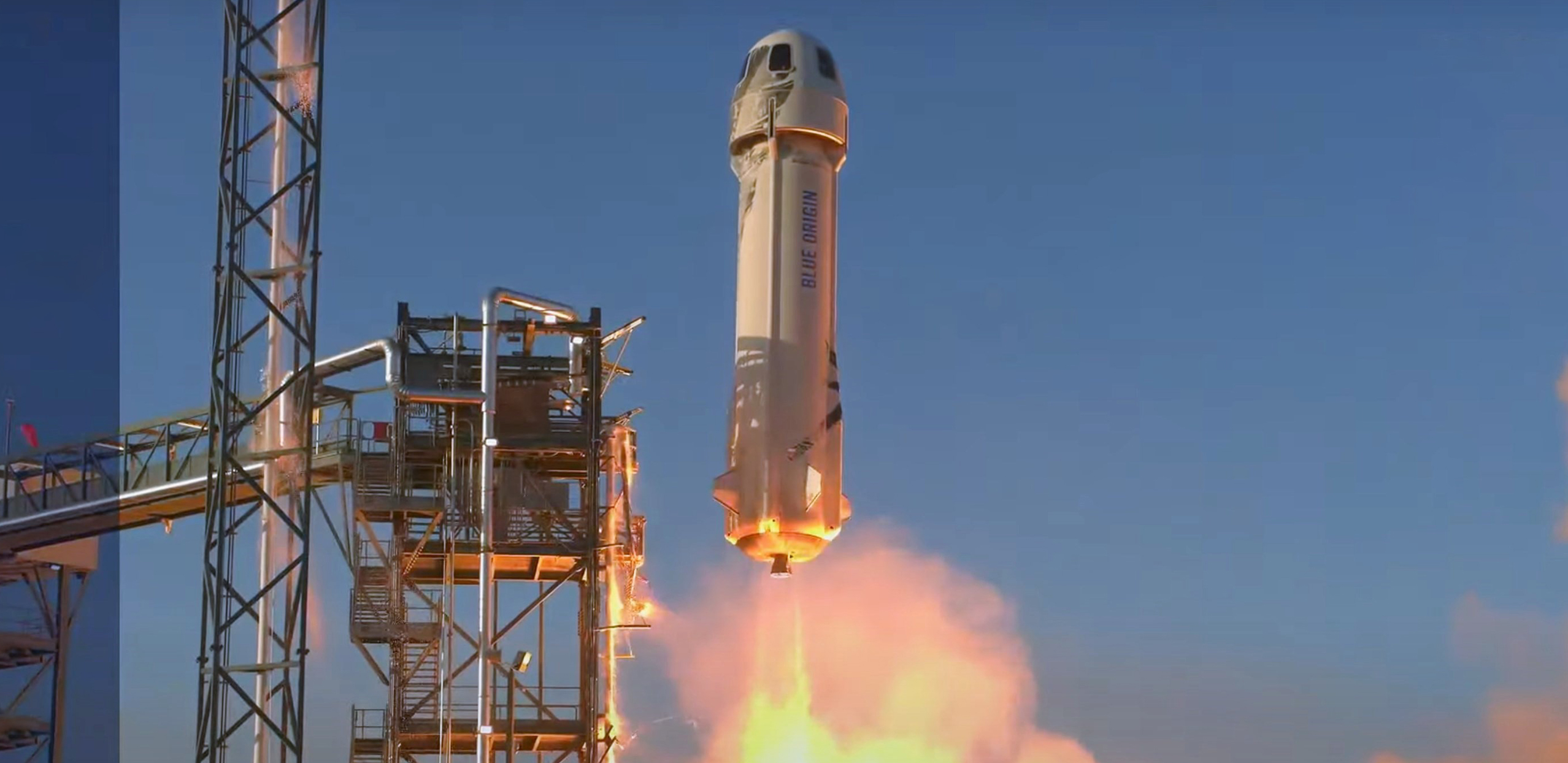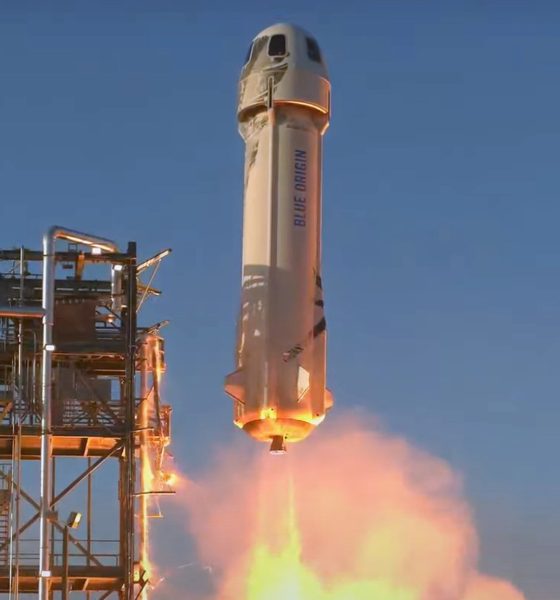

News
SpaceX competitor Blue Origin completes first suborbital launch in 10 months
Prospective SpaceX competitor Blue Origin has completed a suborbital launch of its reusable New Shepard rocket for the first time in 10 months.
Originally designed to help usher in a new wave of space tourism as early as 2017, the tourist launch debut of the New Shepard rocket – alongside fellow tourism company Virgin Galactic’s SpaceShipTwo – appears destined to forever be “a couple flights” away.
Essentially the same diameter as SpaceX’s Falcon 9 rocket, New Shepard measures ~3.6m (~12 ft) wide, ~15m (~50 ft) tall, and likely weighs around 35 metric tons (~75,000 lb) at liftoff. The small rocket booster is powered by one liquid hydrogen and oxygen (hydrolox) BE-3 engine capable of producing ~500 kN (110,000 lbf) of thrust and is designed for what Blue Origin calls “operational reuse”.
In practice, Blue Origin has only built four New Shepards in ~6 years and has never flown the same booster twice in less than ~60 days, despite an effectively blank-check budget from owner Jeff Bezos since the company’s founding in 2000.


It’s truly difficult to fathom why, if New Shepard is capable of semi-rapid reuse, Blue Origin has only launched the small rocket an average of once every six months in the last four years. If the company genuinely wants to routinely launch space tourists above the Karman Line (100 km), actually demonstrating safety with as many consecutively successful launches as possible is a no-brainer given an effectively unlimited budget and schedule.
Put a different way, Blue Origin was technically founded two years before SpaceX. In the 6-7 years since Bezos’ space startup began building the first New Shepard, the company has built just four vehicles total, one of which was destroyed when it failed its first landing attempt. In that same timeframe, SpaceX has built ~50 Falcon 9 and Falcon Heavy boosters and completed 83 successful launches, only one of which was intentional suborbital.
In the ten months it has taken Blue Origin to complete two suborbital launches of the same New Shepard 3 booster, SpaceX has completed 18 Falcon 9 launches, orbited more than 600 self-built Starlink satellites, become the first private company in history to launch astronauts into orbit, shipped the first upgraded Cargo Dragon spacecraft to Florida, landed a booster after a satellite launch for the US military, beat NASA’s Space Shuttle to make Falcon 9 the world’s most rapidly reusable rocket, completed six orbital-class launches with the same Falcon booster, performed two successful Starship hop tests, crushed a decades-old world record with a Raptor engine, and much, much more.


While Blue Origin is technically working on New Glenn – a massive orbital-class reusable rocket with performance similar to Falcon Heavy – and the powerful BE-4 engine, mean to power both New Glenn and ULA’s new Vulcan rocket, both appear to be in the throes of technical difficulties and delays. During Blue Origin’s official New Shepard Flight 13 (NS-13) webcast, the company didn’t mention either program once.
Check out Teslarati’s Marketplace! We offer Tesla accessories, including for the Tesla Cybertruck and Tesla Model 3.

Elon Musk
Starlink achieves major milestones in 2025 progress report
Starlink wrapped up 2025 with impressive growth, adding more than 4.6 million new active customers and expanding service to 35 additional countries, territories, and markets.

Starlink wrapped up 2025 with impressive growth, adding more than 4.6 million new active customers and expanding service to 35 additional countries, territories, and markets. The company also completed deployment of its first-generation Direct to Cell constellation, launching over 650 satellites in just 18 months to enable cellular connectivity.
SpaceX highlighted Starlink’s impressive 2025 progress in an extensive report.
Key achievements from Starlink’s 2025 Progress
Starlink connected over 4.6 million new customers with high-speed internet while bringing service to 35 more regions worldwide in 2025. Starlink is now connecting 9.2 million people worldwide. The service achieved this just weeks after hitting its 8 million customer milestone.
Starlink is now available in 155 markets, including areas that are unreachable by traditional ISPs. As per SpaceX, Starlink has also provided over 21 million airline passengers and 20 million cruise passengers with reliable high-speed internet connectivity during their travels.
Starlink Direct to Cell
Starlink’s Direct to Cell constellation, more than 650 satellites strong, has already connected over 12 million people at least once, marking a breakthrough in global mobile coverage.
Starlink Direct to Cell is currently rolled out to 22 countries and 6 continents, with over 6 million monthly customers. Starlink Direct to Cell also has 27 MNO partners to date.
“This year, SpaceX completed deployment of the first generation of the Starlink Direct to Cell constellation, with more than 650 satellites launched to low-Earth orbit in just 18 months. Starlink Direct to Cell has connected more than 12 million people, and counting, at least once, providing life-saving connectivity when people need it most,” SpaceX wrote.
News
Tesla Giga Nevada celebrates production of 6 millionth drive unit
To celebrate the milestone, the Giga Nevada team gathered for a celebratory group photo.

Tesla’s Giga Nevada has reached an impressive milestone, producing its 6 millionth drive unit as 2925 came to a close.
To celebrate the milestone, the Giga Nevada team gathered for a celebratory group photo.
6 million drive units
The achievement was shared by the official Tesla Manufacturing account on social media platform X. “Congratulations to the Giga Nevada team for producing their 6 millionth Drive Unit!” Tesla wrote.
The photo showed numerous factory workers assembled on the production floor, proudly holding golden balloons that spelled out “6000000″ in front of drive unit assembly stations. Elon Musk gave credit to the Giga Nevada team, writing, “Congrats on 6M drive units!” in a post on X.
Giga Nevada’s essential role
Giga Nevada produces drive units, battery packs, and energy products. The facility has been a cornerstone of Tesla’s scaling since opening, and it was the crucial facility that ultimately enabled Tesla to ramp the Model 3 and Model Y. Even today, it serves as Tesla’s core hub for battery and drivetrain components for vehicles that are produced in the United States.
Giga Nevada is expected to support Tesla’s ambitious 2026 targets, including the launch of vehicles like the Tesla Semi and the Cybercab. Tesla will have a very busy 2026, and based on Giga Nevada’s activities so far, it appears that the facility will be equally busy as well.
News
Tesla Supercharger network delivers record 6.7 TWh in 2025
The network now exceeds 75,000 stalls globally, and it supports even non-Tesla vehicles across several key markets.

Tesla’s Supercharger Network had its biggest year ever in 2025, delivering a record 6.7 TWh of electricity to vehicles worldwide.
To celebrate its busy year, the official @TeslaCharging account shared an infographic showing the Supercharger Network’s growth from near-zero in 2012 to this year’s impressive milestone.
Record 6.7 TWh delivered in 2025
The bar chart shows steady Supercharger energy delivery increases since 2012. Based on the graphic, the Supercharger Network started small in the mid-2010s and accelerated sharply after 2019, when the Model 3 was going mainstream.
Each year from 2020 onward showed significantly more energy delivery, with 2025’s four quarters combining for the highest total yet at 6.7 TWh.
This energy powered millions of charging sessions across Tesla’s growing fleet of vehicles worldwide. The network now exceeds 75,000 stalls globally, and it supports even non-Tesla vehicles across several key markets. This makes the Supercharger Network loved not just by Tesla owners but EV drivers as a whole.
Resilience after Supercharger team changes
2025’s record energy delivery comes despite earlier 2024 layoffs on the Supercharger team, which sparked concerns about the system’s expansion pace. Max de Zegher, Tesla Director of Charging North America, also highlighted that “Outside China, Superchargers delivered more energy than all other fast chargers combined.”
Longtime Tesla owner and FSD tester Whole Mars Catalog noted the achievement as proof of continued momentum post-layoffs. At the time of the Supercharger team’s layoffs in 2024, numerous critics were claiming that Elon Musk was halting the network’s expansion altogether, and that the team only remained because the adults in the room convinced the juvenile CEO to relent.
Such a scenario, at least based on the graphic posted by the Tesla Charging team on X, seems highly implausible.








